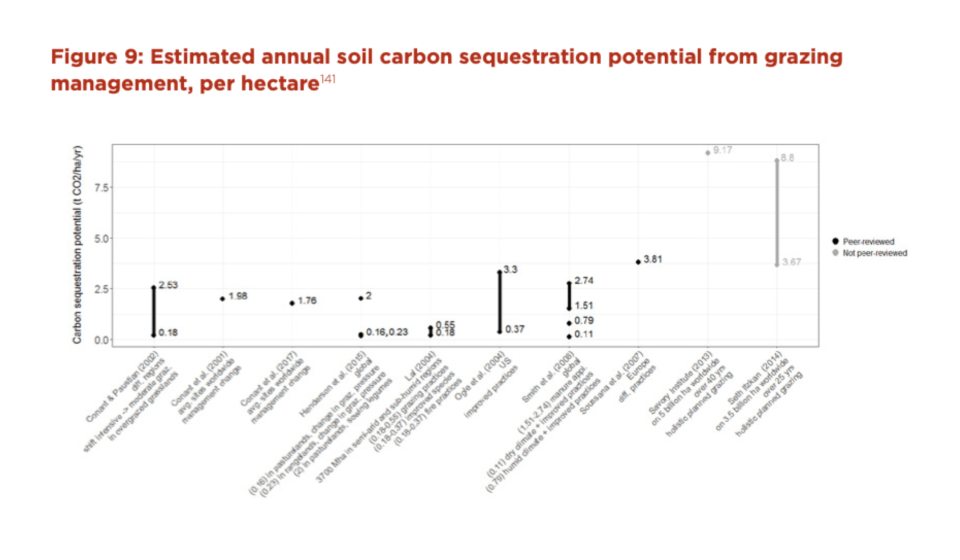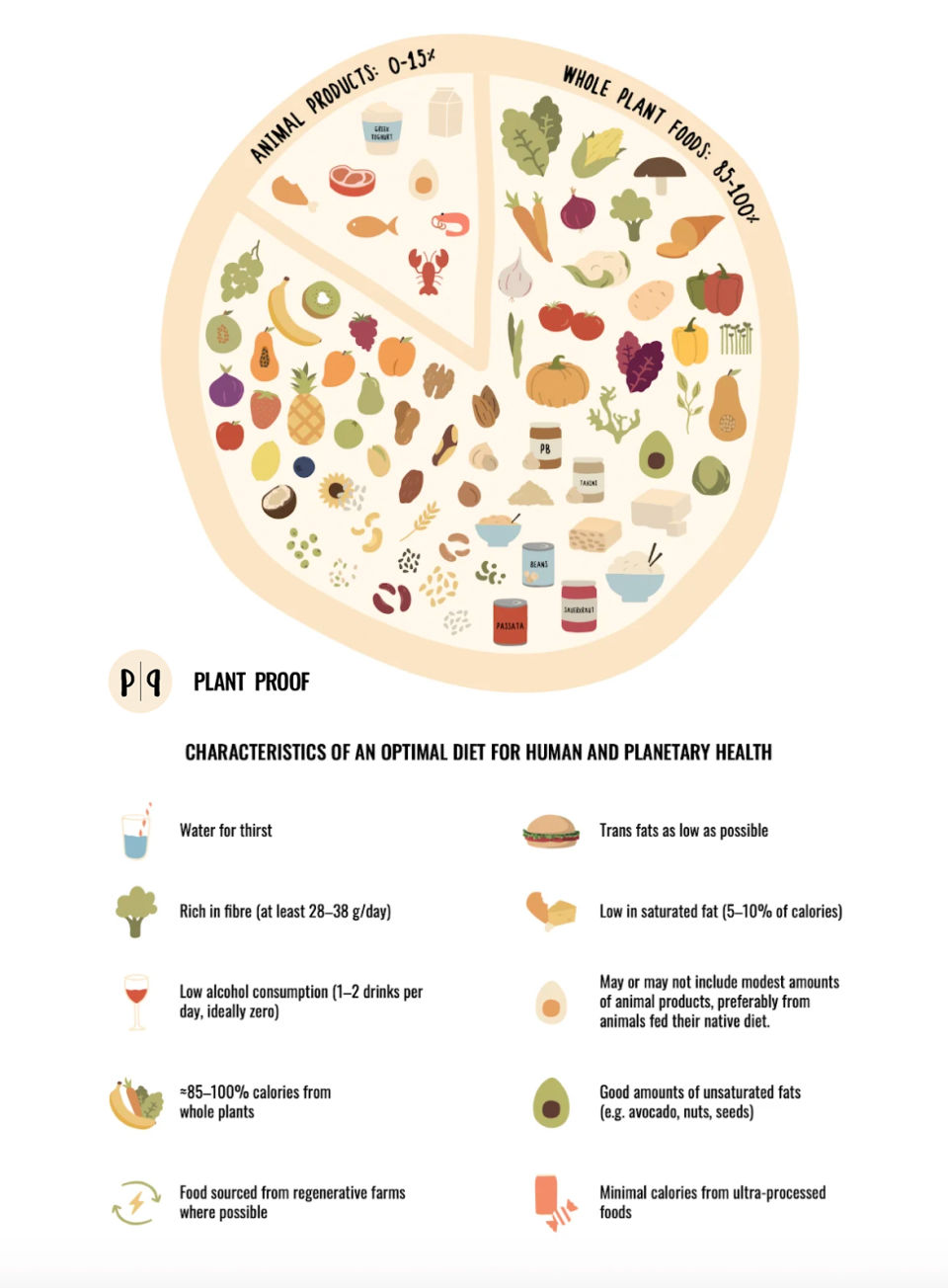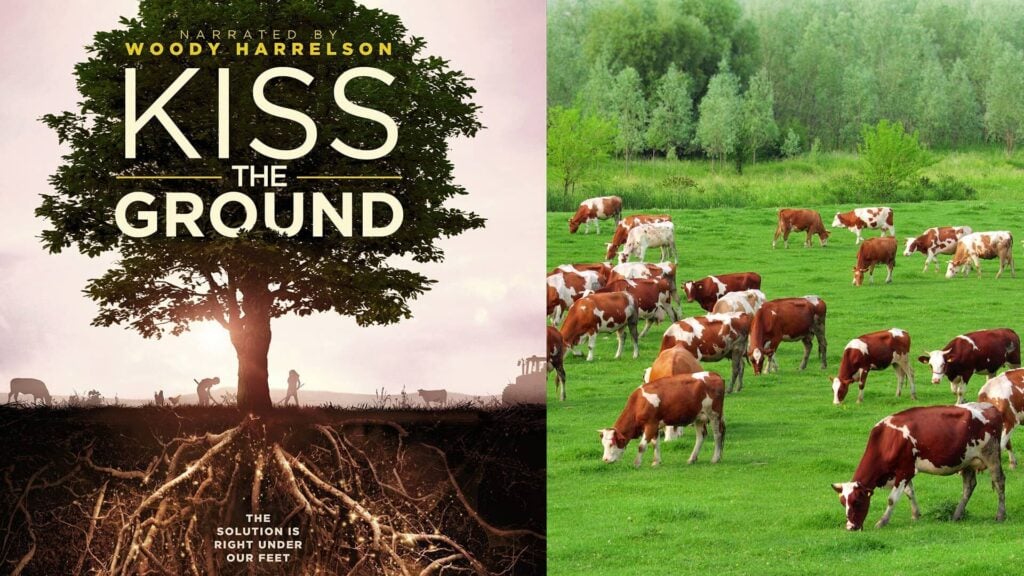
If you have found your way to this article, I can only assume that we have something in common: both of us want to see a better world where humans and all life on earth is thriving.
Having dedicated many years to researching and communicating the science behind an optimal diet for humans, I understand first hand how our health is inextricably tied to the planet’s (as detailed in my upcoming book).
‘No healthy humans without a healthy planet’
Put simply, there are no healthy humans without a healthy planet. With that said, any time a new study, book, documentary, or other media publication is published, I read or watch with great interest.
And of course, having interviewed the co-founders of Kiss the Ground, Ryland Engelhart and Finian Makepeace, in early 2020, I was particularly excited to watch the Kiss the Ground documentary (and I recommend you watch it too if you haven’t already).
Claims
Before we get into a few major claims made in Kiss the Ground that are directly at odds with scientific knowledge, I want to preface this entry by saying that I wholeheartedly support regenerative agriculture as a goal and think the documentary did a great job bringing light to the detrimental impact that intensive animal agriculture is having on our planet.
A degenerative system that decimates life in our soil, releases immense amounts of greenhouse gas emissions into our atmosphere, pollutes our waterways, and disrupts the biodiversity and biology on our land and in our oceans.
I was also pleased the documentary shone a light on food waste and composting – these are two things that many of us can introduce into our daily lives with minimal barriers to entry.
Above all, it’s great to see this conversation growing from what has very much been a fringe movement to now entering the mainstream.
Talking about the importance of being better stewards of our land, and why we must do a better job at protecting our natural resources and ecosystems, is absolutely crucial if our species is to not just thrive on Planet Earth, but survive. It’s within this context, that it becomes so vividly apparent, that in this conversation we are not just talking about planetary health, but at its core, human health.
Falling short
Where I think the documentary falls short is in three critical areas. I’ve listed these below in short, and then we will go through each together looking at the claims made and where the science lies: (These have also been covered in detail with Environmental Researcher Nicholas Carter (co-author of this article) in episode 104 and 111 on the Plant Proof podcast).
1 – Claims that holistic grazing can reverse climate change. This form of regenerative agriculture is by no means the ‘silver bullet’ that it’s so often portrayed to be – and is certainly not what the world’s leading climate scientists are most excited by.
2 – Creation of a false dichotomy. The documentary carefully positions holistic grazing as the answer to intensive animal agriculture (including the mono-cropping that occurs to feed factory-farmed animals). I’m sure we can all agree that factory farming is a blight on humanity, and there is far too much mono-cropping, but assuming that it’s either this intensive form of animal agriculture or holistic grazing, is not accurate. For a great deal of land, there are other, more evidence-based ways to sequester carbon. Unfortunately, these incredibly superior solutions are less sexy because they are not tying livestock, and more specifically the consumption of beef, to the solution.
3 – Unclear about how the proposed solutions would affect our diets. Regardless of the above claims being scientifically supported or not (we’ll come to that) if one is to advocate for a shift to holistic grazing this will inevitably result in a dramatic reduction in global meat supply. In turn, this means shifting to more plant-based diets.

Can Holistic Grazing reverse climate change?
There is enough evidence to support regenerative agriculture being a more environmentally friendly form of agriculture to how we are currently farming, but on the other side, I am also weary whenever a solution is proposed as a panacea for tackling climate change – what is arguably one of the most complex problems that the human race is faced with.
There are three main points I want to make about holistic grazing that are important for you to understand.
The first point that I think deserves our attention, before getting into the science on the reversal claim, is the way the producers wanted you to see holistic grazing. It was very much positioned as absolutely crucial to confronting this climate emergency we find ourselves in. The sort of solution you might suspect is at the top of all climate scientist’s lists.
This positioning starts with the documentary’s focus on the Drawdown Report by Environmentalist Paul Hawken from Project Drawdown. This is a review I’m very familiar with having read through it front to back a handful of times.
I also thoroughly enjoyed Paul’s episode on Rich Roll’s podcast where he speaks at length about Project Drawdown. Essentially, Hawken and his team have created a long list of approximately 100 solutions, which when implemented together, would be capable of drawing down more carbon than we are emitting by 2050. And as the documentary states, shifting us from climate warming to climate cooling.
Presenting the information
Focussing on this review was a clever move by Kiss the Ground – Paul Hawken and the Project Drawdown are incredibly well respected. However, there is a ‘slight’ problem with the way they presented the information from the Drawdown report. What’s glaringly clear from Hawken’s report is that when it comes to our food and greenhouse gas emissions, the two areas we can make the biggest impact are reducing food waste (number one solution)and moving to a plant-rich diet (number three solution).
In fact, if we look at the solutions outlined in the Drawdown Report and their potential to draw down carbon from our atmosphere, shifting to a diet that favours calories from plants is twice as powerful compared to shifting to silvopasture and four times as powerful compared as shifting to managed grazing – two forms of regenerative agriculture that involve livestock.
There was also no mention of tropical forest restoration – which has significantly greater potential at pulling carbon out of the atmosphere compared to grazing cows on land – no matter what practice is employed. You can see all of this here for yourself
Diet change
I’m not suggesting we should only be changing our diet – but given it has greater potential to reduce greenhouse gas emissions you would think it would have been given more emphasis than putting cows on pasture.
The documentary tiptoed around this, failing to make it explicitly clear that the food on our plate has to change, while seemingly wanting us to believe that holistic grazing on its own can reverse climate change.
It only takes a quick read of the Drawdown Report to realize that this is absolutely unfounded – it’s going to take an enormous amount of solutions to radically transform our energy and food systems to reverse climate change, and holistic grazing, while certainly better than intensive farming, is not the miracle carbon-sequestering practice that those watching are led to believe. There’s nothing ‘Netflix and chill’about that.
Flaky science
The next thing I want to address, and perhaps the most important take-home message here, is the science underpinning holistic grazing is flaky at best. Kiss the Ground gave the microphone to Ranchers Alan Savory and Gabe Brown, but we didn’t hear about any legitimate science testing out whether the claims they were making truly hold up?
Sure, it’s easy to see with our own eyes that there is more life on land that is managed in a regenerative way, but in order to really know that it is a climate solution, we would need evidence that carbon levels in the soil are not only increasing but increasing by more than the emissions emitted by the animals involved in the system. I thought it was odd that this was left out.
Although, when I watched it for the third time, it became obvious that the biology 101 lessons from ‘Ray’ were cleverly used to dance around the fact there is no solid science to back up Savory and Brown’s claims. This is where a report written by Dr. Tara Garnett for the University of Oxford becomes very interesting – a report title Grazed and Confused that I have written about before here.
After looking at all of the available evidence on holistic grazing, and claims made by the likes of Savory, the report concludes that ‘grass-fed livestock are not a climate solution’. Grazing livestock are net contributors to the climate problem, as are all livestock. Rising animal production and consumption, whatever the farming system and animal type, is causing damaging greenhouse gas release and contributing to changes in land use. Ultimately, if high consuming individuals and countries want to do something positive for the climate, maintaining their current consumption levels but simply switching to grass-fed beef is not a solution. Eating less meat, of all types, is.
And when it comes to the Savory Institute and Savory’s claims Dr Garnett states that they are ‘generally anecdotal, based on surveys and testimonies rather than on-site measurements’. Sounds pretty ambitious to champion this form of animal agriculture as a climate solution without strong empirical evidence?

This isn’t the only literature review that has found a lack of science to support Savory’s claims about holistic grazing with another detailed review of the literature out of Sweden by Maria Nordborg, coming to the same conclusion. Savory’s claims don’t stand up when you put them under the microscope. Or this breakdown of the many myth’s he perpetuates in The International Journal of Biodiversity.
A huge problem
Now all debates have two sides and Savory has been confronted with this information before. His response: “holistic management does not permit replication”, and “you’ll find the scientific method never discovers anything.”
In other words, his claims cannot be supported by data, replicated by others and he doesn’t believe in science. Makes sense why the documentary didn’t go there! This is a huge problem. There seems to be an incredibly fine line between grazing just enough and overgrazing, which speaks to potentially why credible peer-reviewed science has to date, failed to produce results that come close to what Alan Savory claims.
This is why science is so important. Anecdote and expert opinion or theories are at the bottom of the evidence hierarchy, and it’s not until we see the findings from higher levels of science, reproduced on scale, that we can begin to have confidence in what we are observing. If he is the only one that can achieve the carbon sequestration that he claims, I fail to see how that’s a hopeful solution. And let’s not forget, this is the same man who ordered 40,000 African elephants to slaughter because he incorrectly thought they were damaging the land.
A false dichotomy
A major strategy deployed in the documentary is offering two distinct choices for where consumers should source their food: conventional chemical-filled monocrops, or lush open fields of regenerative agriculture.
This is a major oversimplification of our complex and varied farming system. Firstly, just so we are clear, the majority of the world’s mono-crops are fed to livestock. So what we are talking about here is how to better use the land dedicated to animal agriculture (83 percent of all agricultural land) that is responsible for 80 percent of food-related greenhouse gas emissions yet provides only 18 percent of our total calories.
The elephant in the room during the documentary is that they completely failed to mention that a significant amount of the land dedicated to animal agriculture across the world (not all but certainly a lot) needs to be restored to forests (the number one driver of deforestation is animal agriculture) to get anywhere close to meeting our climate goals.
Forests
Why? Because not only does this mean less greenhouse gas-emitting ruminant animals, but it means we can draw down more carbon from the atmosphere – forests are typically far better at doing this than grasslands.
In fact, in the Drawdown Report, when you factor in the land that would be freed up if the entire world shifted to a plant-rich diet, this becomes the single biggest lever that each of us can pull to lower our individual environmental footprint. So really, the idea of conservation and restoration, needed to be absolutely front and center if Kiss the Ground truly wanted to educate the masses about how agriculture can help tackle climate change.
They also failed to make it clear why ruminants were required. Yes, there’s no doubt ruminant poop can help improve soil quality, but there are many types of regenerative agriculture that do not involve animals or animal manure and others that act as sanctuaries using animals on their land without sending them to slaughter.
One can only presume that the slaughtering of the animal is not about soil quality, but about profits. Don’t get me wrong. Farmer’s need to make profits but we need to be transparent here and lay down all solutions on the table to have an open discussion. Until then, it’s going to be hard to truly transform our agricultural system to benefit all life on the planet.
As a side note, the documentary routinely employed uses numerous fear-mongering tactics to scare the viewer into grasping for whatever solution comes next. A prime example of this is their claim that there is only 60 years of farming left. That sounds catastrophic. However, this was taken from a United Nations speech, which leading soil scientist’s say is absolutely not supported by science.
3. What would a global transition from factory-farmed meat to holistic grazing mean for our diets?
Finally, the ‘elephant’ / ‘cow’ in the room (not sure which is more fitting) during Kiss the Ground is how are we going to produce enough meat using holistic grazing to meet current demands?
There are a few clues within the documentary that speak to this but they are by no means overtly clear to the viewer. The first clue is when the documentary makes mention of the natural history of Bison roaming the United States. They correctly state that Bison would pass through land and not be seen for around a year. To rotate cows like bison, it means leaving land free from roaming animals for at least six-nine months – a figure that Alan Savory states himself in the documentary.
This means that compared to factory farms, or traditional grazing where cows are overgrazing and destroying the soil, a regenerative farm using holistic grazing would require a lot more land for any given number of roaming cows.
Meat consumption
Unfortunately, overtly telling people they need to cut down on their meat consumption for this change in agriculture to work isn’t going to help with the documentary’s popularity. But it’s the reality we face. Factory farms are good at one thing – producing a lot of meat in a short period of time to feed a growing appetite for meat.
If we pull the pin on that, it means one thing and one thing only. Less meat to go around and significantly higher prices per unit. And this isn’t just my own speculation. If the U.S shifted away from intensive livestock farming to traditional grazing, it’s been calculated that the available grasslands would only be able to produce 27 percent of the countries current beef supply.
In other words, a 73 percent reduction in beef available per person in the U.S. For holistic grazing, that figure would be even higher because it requires far more land per cow and thus produces significantly less beef than the traditional more intensive grazing systems.
As prices go up, pending one spends the same budget they had previously set aside for meat, their consumption naturally falls. Unfortunately, Savory seems to have led himself to believe that his unscientific approach should be expanded across the world – really, tear down more forests to make room for holistic grazing? This sounds like something else that he would likely regret in the near future.
Plant-rich diets
While, there were very subtle hints that people would have only caught if paying very close attention, it was not made overtly clear by the documentary that the proposed solutions means transitioning the world to plant-rich diets.
There was mention of a ‘regenerative diet’ but what does that mean? Why not let the viewer know what the world’s leading climate scientists have to say about diet? Data from almost 40,000 farms, and 119 countries, clearly shows us that a plant-based diet results in less greenhouse gas emissions, less pollution, less ocean acidification, and uses less water and land – land which we can therefore ‘free up’ and convert to forests to rapidly sequester carbon from our atmosphere. This seems like pretty important information that was left off the table.
Despite the documentary not spelling it out, it’s very clear. If we want to lower our environmental footprint the single most important thing we can do is eat more plants. Yes, what’s on our plate is even more important than where it’s come from or ‘buying local’. As Hannah Ritchie, Phd (Geosciences) puts it: “Whether you buy it from the farmer next door or from far away, it is not the location that makes the carbon footprint of your dinner large, but the fact that it is beef.”
The bonus being that plant-rich dietary patterns just so happen to also be what major health institutions and progressive Government departments like Health Canada are advocating for to tackle rising rates of obesity and chronic disease, and improve quality of life.

Grassfed
The problem is, the lay viewer who is not across the science, and blinded by the message of ‘hope’, is likely to confuse the role of cows in holistic grazing with instruction that we should continue eating meat at current rates (as long as it’s ‘grass-fed’) and perhaps even double down on our meat consumption.
As long as it’s ‘grass-fed’. After all, this method of grazing, which Gabe Brown and Alan Savory speak about at length, is being positioned in the documentary as the solution we have all been waiting for to reverse climate change. A powerful message during a time where the climate emergency is without a doubt causing climate anxiety. But what good is hope if it’s false?
And as we all know, this creates a slippery slope. Consumers falsely see meat as part of the solution, and although they may do their best to seek out regenerative meat (<one percent of the market currently) most will inevitably continue to support factory farming and intensive grazing practices when eating out at restaurants or shopping at major supermarket chains. In many ways, this stands to do more harm than good.
A compelling case
Despite all of this, my fear is that many will be left with a complete misunderstanding of where environmental science truly lies. Why? Because where Kiss the Ground lacks in science, it makes up in celebrity power – with the likes of Woody Harrelson, Jason Mraz, Ian Somerhalder, Gisele Bündchen, and Tom Brady all featured.
The documentary is well-produced and in the eyes of a layperson an extremely compelling case for changing the way we grow food. However, given the notable absence of well qualified environmental scientists discussing evidence to support their ambitious claims, in favor of anecdotal experience from ranchers, just how much of the information in this documentary can we trust and reliably use to shape our food system and inform our food choices? Unfortunately not as much as I had hoped.
A Regenerative Diet
So if Kiss the Ground had taken a more evidence-based approach and included dietary recommendations what would it have looked like?
I would simply build on the work of Michael Pollan, a well-known science writer: “Where possible eat regenerative food, not too much, mostly plants.”
Practically speaking this looks like the plate below – perhaps this could be ‘The Regenerative Plate’ that Kiss the Ground adopts in their communication going forwards.
A plant-rich dietary pattern that places emphasis on regeneration but really could be chopped in a number of ways to suit the individual – Mediterranean, paleo, pescatarian, vegetarian, vegan, etc can all be done in a plant-predominant manner. The central tenant is that it’s a diet that places enormous emphasis on calories from plants and de-emphasizes calories from animal products. I’d be willing to donate it to them.

Plant-exclusive diet
Regardless of the label that we choose to adopt, eating this way will nourish the soil, reduce emissions from agriculture, and at the same time reduce the burden of chronic disease in our communities.
For me, it’s a plant-exclusive diet and for you it might be eating plant-based before dinner – often the perfect place for people to start.
Either way, shifting the typical diet in such a way is a certain win for humanity and all life on Earth, and thus something that not only should have been made clearer in Kiss the ground, but something that everyone reading should strongly consider.







